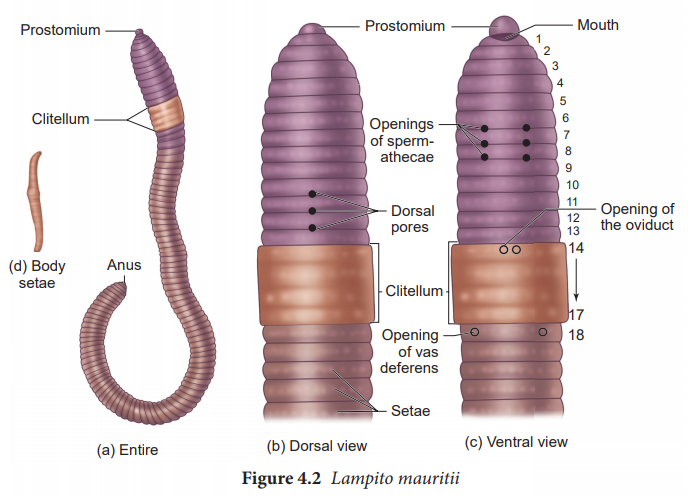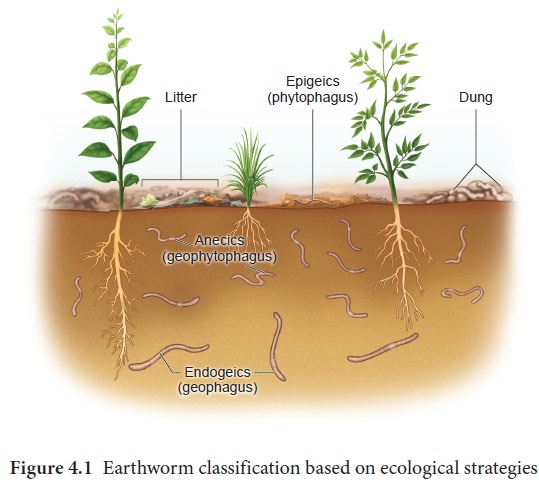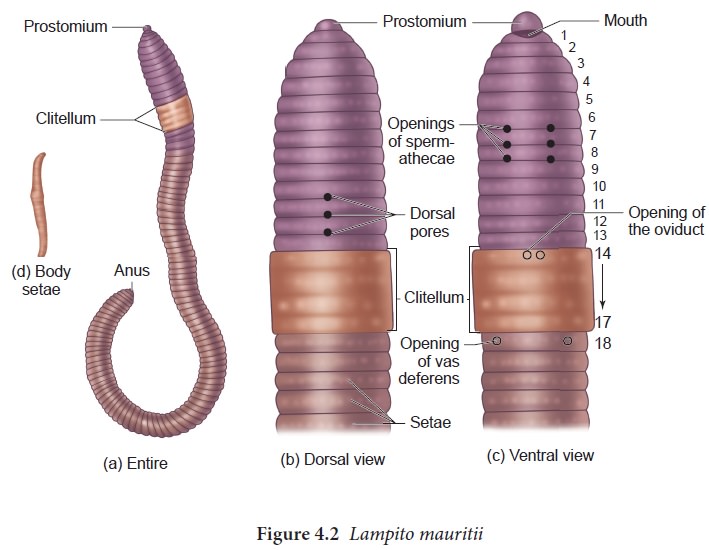Chapter: 11th Zoology : Chapter 4 : Organ and Organ Systems in Animals
Morphology of Earthworm (Lampito mauritii)

Earthworm - Lampito mauritii
Earthworm
is a terrestrial invertebrate that inhabits the upper layers of the moist soil,
rich in decaying organic matter. It is nocturnal and during the day it lives in
burrows made by burrowing and swallowing the soil. In gardens, they can be
traced by their faecal deposits known as worm castings on the soil surface.
Earthworms are considered as “Friends of Farmers”. The common Indian earthworms
are Lampito mauritii (Syn. Megascolex mauritii),
Perioynx excavatus and Metaphire
posthuma (Syn. Pheretima posthuma). Earthworms are also conveniently
classified based on their ecological strategies as epigeics, anecics and
endogeics (Figure 4.1). Epigeics (Greek for “up on the earth”) are surface
dwellers, eg. Perionyx excavatus and Eudrilus eugeniae. Anecics (Greek for “out
of the earth”) are found in upper layers of the soil, eg. Lampito mauritii,
Lumbricus terrestris. Endogeics (Greek for “within the earth”) are found in
deeper layers of the soil eg. Octochaetona thurstoni.

Morphology
Lampito mauritii is commonly found in Tamil Nadu.
It has a long and cylindrical narrow
body which is bilaterally symmetrical. L. mauritii is 80 to 210 mm in length
with a diameter of 3.5 – 5 mm, and is light brown in colour, with purplish
tinge at the anterior end. This colour of the earthworm is mainly due to the
presence of porphyrin pigment. The body of the earthworm is encircled by a
large number of grooves which divides it into a number of compartments called
segments or metameres (Figure 4.2). L. mauritii consists of about 165 – 190
segments. The dorsal surface of the body is marked by a dark mid dorsal line
(dorsal blood vessel) along the longitudinal axis of the
body. The ventral surface is distinguished by the presence of genital openings.
The mouth is found in the centre of the first segment

Overhanging the mouth is a small flap called the
upper lip or prostomium. The last segment has the anus called the pygidium. In
mature worms, segments 14 to 17 may be found swollen with a glandular
thickening of the skin called the clitellum. Thishelps in the formation of the
cocoon. Due to the presence of clitellum, the body of an earthworm is divided
into pre clitellar region (1st – 13th segments), clitellar region
(14th – 17th segments) and the post – clitellar region (after the 17th
segment). In all the segments of the body except the first, last and clitellum,
there is a ring of chitinous body setae. This body setae arises from a
setigerous sac of the skin and it is curved as S – shaped. Setae can be
protruded or retracted and their principal role is in locomotion.
The
external apertures are the mouth, anus, dorsal pores, spermathecal openings,
genital openings and nephridiopores. The dorsal pores are present from the 10th
segment onwards. The coelomic fluid communicates to the exterior through these
pores and keeps the body surface moist and free from harmful microorganisms.
Spermathecal openings are three pairs of small ventrolateral apertures lying
intersegmentally between the grooves of the segments 6/7, 7/8 and 8/9. The
female genital aperture lies on the ventral side in the 14th segment
and a pair of male genital apertures are situated latero-ventrally in the 18th
segment. Nephridiopores are numerous and found throughout the body of the
earthworm except a few anterior segments, through which the metabolic wastes
are eliminated.
Related Topics